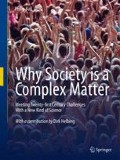Abstract
Early social statisticians in the nineteenth century were astonished to find that the prevalence of crimes from year to year followed a precise mathematical pattern. Specifically, variations from the long-term average fitted onto a bell curve – the same curve that described variations in births and deaths, or in errors in experimental measurements. This means that small deviations from the average happen more often than large ones, and that very large deviations tend to be vanishingly rare. How could it be that these acts of crime, committed with free will, obeyed such regularity? To some, such as the influential Belgian mathematician Adolphe Quetelet, this meant that crimes must be somehow compelled by a higher force – not by individual choices, but by “the customs of the people”, and that they must therefore be regarded as an inevitability: a “budget that is paid with frightening regularity”.
Access this chapter
Tax calculation will be finalised at checkout
Purchases are for personal use only
Further Reading
L. Liu & J. Eck (eds), Artificial Crime Analysis Systems: Using Computer Simulations and Geographic Information Systems. Hershey, Pa., Information Science Reference, 2008.
Special issue on Simulated Experiments in Criminology and Criminal Justice, J. Exp. Criminol. 4(3), 187–333 (2008).
E. R. Groff, ‘Simulation for theory testing and experimentation: an example using routine activity theory and street robbery’, J. Quant. Criminol. 23, 75–103 (2007).
E. R. Groff, ’‘Situating’ simulation to model human spatio-temporal interactions: an example using crime events’, Transactions in GIS 11, 507–530 (2007).
N. Malleson & M. Birkin, ‘Towards victim-oriented crime modelling in a social science e-infrastructure’, Phil. Trans. R. Soc. A 369, 3353–3371 (2011).
N. Malleson, L. See, A. Evans & A. Heppenstall, ‘Implementing comprehensive offender behaviour in a realistic agent-based model of burglary’, Simulation: Trans. Soc. Model. Simul. Int. doi: 10.1177/0037549710384124 (2011).
N. Malleson, A. Evans & T. Jenkins, ‘An agent-based model of burglary’, Envir. Planning B: Planning & Design 36, 1103–1123 (2009).
K. Keizer, S. Lindenberg & L. Steg, ‘The spreading of disorder’, Science 322, 1681–1685 (2008).
M. B. Short, P. J. Brantingham, A. L. Bertozzi & G. E. Tita, ‘Dissipation and displacement of hotspots in reaction-diffusion models of crime’, Proc. Natl Acad. Sci. USA 107, 3961–3965 (2010).
Author information
Authors and Affiliations
Rights and permissions
Copyright information
© 2012 Springer-Verlag Berlin Heidelberg
About this chapter
Cite this chapter
Ball, P. (2012). Broken Windows: The Spread and Control of Crime. In: Why Society is a Complex Matter. Springer, Berlin, Heidelberg. https://doi.org/10.1007/978-3-642-29000-8_4
Download citation
DOI: https://doi.org/10.1007/978-3-642-29000-8_4
Publisher Name: Springer, Berlin, Heidelberg
Print ISBN: 978-3-642-28999-6
Online ISBN: 978-3-642-29000-8
eBook Packages: Physics and AstronomyPhysics and Astronomy (R0)

